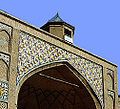| Soltani Mosque of Borujerd | |
|---|---|
 Great Yard of Sultani Mosque | |
| Religion | |
| Affiliation | Islam |
| Location | |
| Location | Iran |
| Geographic coordinates | 33°48′N48°30′E / 33.80°N 48.50°E |
| Architecture | |
| Type | Mosque |
| Date established | Qajar era |
| Site area | 7,000 m2 (75,000 sq ft) |
The Soltani Mosque of Borujerd is a mosque in the centre of Borujerd, in the province of Lorestan, western Iran.
Contents
The edifice was built in the Qajar period atop the ruins of an older mosque, which had been probably built in the 10th century AD. Soltani means "related to Sultan," and likely refers to Fath Ali Shah Qajar, who ordered this building to be rebuilt. [1]
Soltani Mosque of Borujerd was known as Masjed Shah in the Pahlavi dynasty and today it is called Masjed-e Imam Khomeini. However, it was badly damaged during the 2006 Borujerd earthquake.









